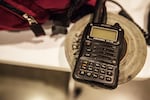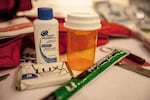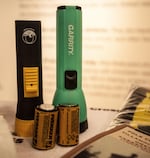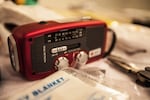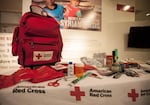
In the event of a natural disaster, each household should have one gallon of purified water, per person, per day, stored. It's recommended that each family have two weeks worth of water at the minimum. For a family of four, that equates to 56 gallons of water.
Alan Sylvestre / OPB
The New Yorker article "The Really Big One" triggered a wave of emotional reactions across our region.
See: Panic
See: Indifference
Or, see your social media feed flooding with that same article being shared by a number of concerned out-of-town relatives.
The feature accomplished a feat of great journalism: It started (or re-started) an important conversation. Now the Oregon Office of Emergency Management wants Oregonians to seize the moment.
"We want Oregonians to be prepared not scared," said OEM Director Andrew Phelps in a statement Friday. "What we do now to prepare will save lives and property during any disaster."
Phelps and other disaster managers are pushing that point because the Cascadia Subduction Zone Earthquake is not the apocalypse. Most of us will live through it when it happens. But what our lives look like afterward as we begin to rebuild — or how much we will need to rebuild — depends on what we do now.
"Now is a perfect time for everyone to evaluate a family emergency plan and update or establish emergency kits," said Althea Rizzo, a geologic hazards coordinator for OEM. "Make sure you and family members know about established exit routes, contacts, meeting places, etc., after a disaster."
Once you do this, guess what, you’re going to feel better about this megaquake.
Take it from Ed Jahn, OPB's reporter who has been researching this topic since 2011. It's pushed him to get his quake kit together.
“I've done these things and I no longer have to spend my days worrying," he said. “I can't prevent an earthquake — I can only take care of what I can take care of.”

The Johnsons use electric lanterns to prepare a meal in the dark at their home in Southeast Portland.
John Rosman / OPB
Or take it from The Johnsons, a couple OPB profiled as they lived off their emergency supply kits for a weekend. They were unprepared when they started. But over the course of the weekend they learned an important lesson: Preparedness is an investment.
“Every month or every pay period, decide on one thing to add to your kit. So that little by little you have more things,” said Sara Johnson. "Instead of looking at (it) like, ‘This is so overwhelming. I’m just not going to do anything at all.’ ”
Rizzo agrees. "You don't have to run out and spend a lot of money," she said. "If you go camping, you probably have a lot of your preparedness already done."
Let’s start with practice.
Oregon OEM has their annual Great Oregon ShakeOut Drill on Oct. 15. It's a great way to learn what to do during and after an earthquake.
Learn The Location Of Your Gas Shut Off
Find Out What National Leaders In Readiness Say
Here's our full series we've been unrolling since January about the state getting more prepared for the megquake.


